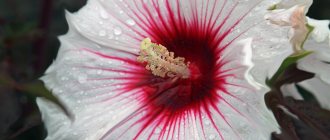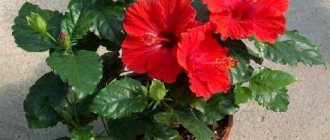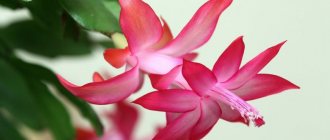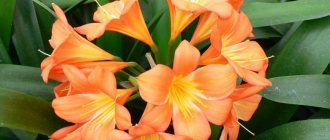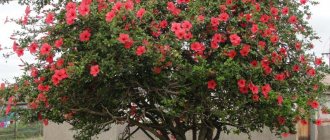General features of the Chinese rose
The Chinese rose plant is considered a tree-like shrub and, when cared for indoors, grows approximately 2 m in height. The plant blooms with large single flowers, which can be red, white, orange and other colors.
As a rule, each flower pleases for 1-2 days, then gradually dries out, but with proper care, the total flowering period can be from early spring to late autumn.
This plant is divided into more than 500 varieties, each of them is beautiful in its own way and has certain care requirements, so the description of the flower may vary. There are varieties that are considered not only decorative, but can also be used in cosmetology, medicine, products...
Description of a rose in the form of a tree
Rose Geisha (Geisha) - growing features
Depending on the height of the trunk to which the rose is grafted, the following types of standard trees are distinguished:
- dwarf, whose height is only 30-50 cm;
- semi-standard up to 80 cm high;
- ordinary trunks, whose average height is 1.3 m;
- high-standard varieties are the tallest tree roses, the height of which can reach up to 3 m, and the branches always have a drooping shape.
Note! All grafted varieties retain their original properties.
Nuances in caring for hibiscus
Caring for the Chinese rose at home should be clear, systematic and, of course, correct, only in this case the plant will be healthy and evergreen, and will delight with flowering for many years. For healthy growth, the Chinese rose needs:
- Correct location with optimal temperature and humidity.
- Timely watering and fertilizing.
- Regular pruning and replanting of the plant according to the norms of its age.
- Quite a large amount of space and good soil.
If you adhere to all these points, then the Chinese rose will not get sick, but will grow healthy and, accordingly, bloom and decorate the interior.
Wild rose - what kind of flower is it?
The second and most common name of the flower is rosehip. In total, there are more than 75 varieties of this shrub, which is surprising, since most people know and have seen no more than 4-5 varieties.
Rosehip berries
The plant belongs to the Rosaceae family. Almost all types of common rose hips can be found in all regions of the country, with rare exceptions.
Interesting! You can tell the time by the wild rose, as its flowers open and close almost like clockwork.
Description of what it looks like
Description of wild rose:
- life form - bush;
- the stems are most often green, covered with many small thorns;
- the flowering period lasts from the second half of May and ends in mid-summer;
- the fruits ripen in September;
- the flower is simple, with many stamens;
- the color depends on the variety - from white to bright pink;
- The colors of the fruits are also varied.
Since rosehip is a monoecious plant, it requires a partner for pollination, otherwise there will be no fruit. Self-pollination rarely occurs; more often, the attraction of pollinating insects is required, which willingly flock to the pleasant, bright aroma of the flower.
Requirements for the location of hibiscus
It is best to place the hibiscus in a place where there is a lot of diffused light. It is worth noting that it is better to protect the indoor plant from direct warm sunlight so that the leaves do not get burned.
Hibiscus absolutely cannot tolerate the slightest drafts, so even during the period of airing the room, it is better to take the flower to another room. The optimal air temperature is considered to be +18-25 degrees Celsius in the summer, and in the winter the minimum temperature is +15 degrees Celsius.
This plant feels comfortable at high air humidity. It is necessary to systematically spray the plant, but do not allow water to get on the flowers, because they may become stained or wither faster.
What care does a tree rose need?
Standard roses are quite capricious ladies. During the growing season they are especially demanding. It is necessary to monitor soil moisture, looseness and do not forget about periodic feeding of the soil. Preventive measures against pests and diseases should be carried out. The same measures are carried out with rooted plants. On especially hot days, do not forget about regular watering; it is also necessary to periodically irrigate the crown of the tree so that it does not dry out. Rose does not like being close to weeds, and therefore needs to be weeded periodically. The soil needs to be loosened so that the roots of the plant can “breathe”. Fertilize the plant in the spring, before the leaves bloom on the branches. At the end of summer, the soil is fertilized with potassium. Pruning roses is done not only to remove diseased and damaged branches, but also to form a beautiful crown. The first pruning after planting the tree is done short, leaving 15 cm from the base of the trunk. For an “adult” plant, pruning is done as necessary and always for the winter. It is necessary to remove the growth that appears at the roots. In order to prevent thickening and maintain the beautiful shape of the crown, it is also necessary to cut off the shoots that grow inside the crown. Before pruning, tools must be treated with potassium permanganate.
The tree rose does not tolerate cold weather, so it needs to be covered for the winter. If the trunk of the plant is flexible enough, then it must be carefully bent to the ground and fixed. A small amount of earth is thrown on top. If the trunk does not bend, then it is wrapped in covering material. If winters are too harsh, the plant is dug up and stored in the basement.
How to water and fertilize a Chinese rose
Since the Chinese rose indoor flower grows very well in a room with high air humidity, watering is required abundantly, but not too often.
Before watering the flower, it is advisable to stand the water and wait for the top layer of soil to dry. In autumn and winter, the amount of watering is slightly reduced; the water should always be at room temperature.
Chinese rose must be fed and fertilized with mineral complexes. Experts recommend applying fertilizer 2 times a month from April to September.
It is best to use liquid fertilizers that contain iron, copper, and nitrogen. In winter, fertilizing is necessary only at the time of flowering; the fertilizer must contain phosphorus and potassium.
Before you start treating the plant with fertilizers, you need to water it well. Florists also advise feeding the flower in the evening.
Popular types and varieties of indoor roses for the home
| View | Description |
| Bengal | It is no more than 20 cm in height, has small carved leaves and large buds. They can be any color, but red shades are the most common. There are terry varieties. Capable of blooming all year round. Easy to care for and does not require pruning. The aroma is weak and not very pronounced, so you can put a pot of this rose in the bedroom. Popular varieties are Katerina Violette, Hemti Demti, Baby Carnival. |
| Remontantnaya | Reaches a height of 30 cm. It has small leaves and medium-sized buds, reminiscent of a glass with its elongated shape. Care is simple, you can achieve constant flowering, but usually this happens no more than twice a year. Quite cold resistant. Popular varieties of this species include Etienne Leve, Frau Karl Druschki, Ulrich Brunner fis. |
| Polyanthus | The dwarf rose is also no higher than 30 cm in height. Obtained as a result of many years of breeding work on crossing multi-flowered Japanese and Chinese tea roses. It has many subspecies, including those with double or semi-double flowers, with brush-shaped buds, and paniculate inflorescences. Capable of blooming from early summer to mid-winter. Due to its high frost resistance, it is often used to decorate borders and terraces. The most popular varieties are Orange Triumph, Clotilde Super, Miniature. |
| Hybrid tea | It is generally accepted that this species was bred in India and obtained through selection of Bengal and garden ones. Different varieties of tea rose have different heights - from 20 cm to 2 m for the whip variety. The flower is small in size, usually of delicate shades and with a delicate, refined aroma. The leaves are small, light green in color. They can bloom all year round, but do not tolerate high humidity and low temperatures. The most popular varieties are Peer Gynt, Gloria Dee, Apricot Silk, Prima Ballerina. |
| Mix Danika | It is distinguished by its small height (up to 30 cm) and the average size of buds of various shades. Loves a lot of sunlight and abundant, but not frequent watering. The leaves are small, rich green. The most famous varieties: Cornada, Parade, Mini mix, Favorite, Beau Monde. |
| Miniature | Obtained by crossing two other species - hybrid tea and polyanthus. Small buds have a delicate aroma and are collected in large inflorescences. The leaves are medium sized, light green. Unpretentious, usually bloom seasonally. Popular varieties include Amulette, Green Ice, Apricot, Sunblaze. |
| Ground cover | They are bred on the basis of similar varietal garden roses, therefore they are distinguished by a variety of shapes, shades and sizes of flowers and leaves, different flowering periods and frost resistance. A distinctive feature is creeping shoots and unpretentiousness. Famous indoor varieties: Alba, Magik, Fairy. |
Today there are about 300 varieties of Chinese roses in the world, and every year amateur breeders receive new ones.
Popular varieties of domestic roses:
| Variety | Flower | Leaves | Peculiarities |
| Baby Masquerade | Up to 3-4 cm in diameter, the chameleon changes color several times during flowering, usually from lemon to pink and red. Has a delicate scent. | Dark green, glossy surface, small in size. | The height of the bush is up to 30 cm, there are almost no thorns. It is easy to care for and resists pests well. |
| Angela Rippon | The size is up to 3-4 cm, the aroma is sharp but pleasant. There are up to 5 buds in an inflorescence. | Small, dense texture, dark green. | The height of the bush is up to 40 cm, highly branched. Needs treatment for powdery mildew and black spot, but does not require pruning. Feed frequently, in small portions. |
| Easter Morning | Color - creamy white. Terry. In inflorescences there are up to 25 pieces. Large size - up to 4 cm in diameter. | Hard, glossy, dark green. | Resistant to diseases, especially fungal ones. Blooms all year round. |
| Fire Princess | There are 3-5 pieces in an inflorescence. Terry. Color - orange-red. | Small, dark green, shiny, carved edges. | The height of the bush is up to 40 cm. It has a branched shoot structure. Susceptible to powdery mildew and black spot. |
| Hummingbird | Terry, up to 5 cm in diameter, up to 25 petals in a bud. Color ranges from orange-yellow to deep apricot. Has a delicate aroma of tea rose. The inflorescence consists of 3-5 pieces. | Quite large, dense texture, glossy. | The maximum height of the bush is 35 cm. It blooms several times a year. |
| Yellow Doll | Color ranges from pale lemon to deep yellow. Terry, up to 50 petals in a bud. | Dark, thick and small. | Up to 30 cm tall. |
| Stars and Stripes | Diameter up to 4 cm, stripes on the petal alternate - white, crimson. There are up to 5 pieces in an inflorescence. | Shiny, medium size, light green. | The first striped variety, bred in the USA in 1975. Many new ones have emerged based on it. The height of the bush is up to 50 cm. The branching is small, there are practically no thorns. High resistance to diseases. Year-round flowering. |
| Green Ice | The buds are pink. The blooming flower is white with a green tint. Terry. There are 3-5 pieces in an inflorescence. | Medium size, rich green color. | The bushes are large - up to 60 cm high and 80 cm wide. High resistance to diseases. Flowering is wavy, year-round. |
When to prune and replant hibiscus
Hibiscus requires timely pruning and replanting, namely, after the plant has flowered, it is worth cutting off all the shoots. With the onset of spring, it is best to pin down all shoots.
When shoots grow inside the bush or parallel to the base of the plant, they also need to be pruned. As a rule, such an ornamental plant tolerates pruning well at any time of the year.
Until the plant is 5 years old, it needs to be replanted once a year, then it will be enough to replant it once every 3-4 years. The most optimal soil for growing hibiscus is a mixture that includes sand, leaf and humus soil.
If the plant is still young, it is advisable to add peat soil. The right time to transplant Chinese roses is spring.
Action plan for replanting hibiscus:
- Sterilize the flower pot.
- Prepare the soil.
- Remove the plant from the pot directly with the soil, just shake it slightly.
- If there are rotten roots, they need to be removed.
- Place the plant in a new flower pot in the center and sprinkle with soil, shake from time to time and lightly compact the layer.
- Water and spray the plant generously.
- Place the plant in its original place.
It is worth noting that after transplantation the plant cannot be moved to a new location.
Selection of standard rose seedlings
Rose Polka - features of a popular flower
It is preferable to buy standard roses in containers, since this is how they are more sensitive to lack of liquid. The minimum diameter of the stem should be 1 cm, for weeping high-standard roses - 2 cm.
Important! There should be no damage to the plant, even the slightest.
The crown should already be of the correct shape and have several powerful branches. In the future, it will be possible to form a beautiful dense crown if 2 buds are budded on one rootstock at once.
Europeans are luckier; in some nurseries they implant 3 buds at once. Therefore, it makes no sense to buy a plant with only 1 bud, since as it grows, it will not be possible to form a crown shape.
If you buy a seedling in a pot, then the height of the flowerpot cannot be less than 25 cm. The plant itself should be easily removed from there, and the root system should entangle the entire earthen ball.
Note! Unscrupulous nursery owners often plant the plant in a container on the eve of purchase. This is very bad.
Signs of poor quality planting and care of tree roses are:
- dry or waterlogged soil;
- presence of weeds;
- the presence of moss on the surface of the substrate.
The engraftment of a standard rose with an open root system should be given even more attention. If buds have sprouted on such seedlings or, especially, young shoots have grown, it is better not to take such a plant. And if the gardener is also a beginner, then it is worth looking for a nursery that will sell plants in pots.
Standard roses in the nursery
Methods for propagating hibiscus
As a rule, hibiscus is propagated in several ways:
- using seeds is the best option for sowing in winter. First, the seeds of the Chinese rose must be well soaked in the solution. A plant grown using this method begins to bloom after 2-3 years;
- through cuttings - the simplest and easiest way to grow this plant and begins to bloom after 1 year. It is best to plant hibiscus using this method in the autumn month.
How to trim correctly
If you trim a flower correctly, this will allow it to bloom much earlier than expected and form a larger number of shoots. It is necessary to prune dry or damaged shoots. This is important to do even for healthy branches that are shortened by half.
It is important to remember that shaping a bush during budding or flowering can greatly harm the rose.
Advice! Cuts and wounds must be treated with garden pitch or charcoal. With the help of the branches obtained after pruning, you can perfectly propagate the Chinese rose.
To rejuvenate an adult bush, all shoots are pruned at a height of 10 cm. At least one bud must be left on each branch. A second pruning is carried out in the summer. This procedure will allow you to get new shoots by the beginning of autumn. In this case, even indoors, the rose will bloom all winter.
Spring pruning of Chinese roses
Problems and diseases of hibiscus
The photo of the Chinese rose attracts attention with its lush green leaves and large colorful flowers. But if not properly cared for, this plant can get sick and lose all its attractive features.
The most common diseases and problems of hibiscus:
- buds falling off - occurs due to insufficient watering, low air temperature;
- leaves dry and curl up - very dry air;
- the appearance of yellow leaves - occurs when watering with poor water or at low air temperatures;
- there are pink spots on the leaves - due to insufficient light or excess fertilizer.
Pests often include aphids, spider mites or scale insects.
Propagation of eustoma by seeds
Eustoma is easily pollinated and produces capsules with many small seeds with high germination rates. Lisianthus seeds are sown superficially on a sterile substrate, under film or glass. The temperature during seed germination should not exceed 25 degrees. Eustoma shoots appear after 10-12 days; at first they develop slowly. The daytime temperature of the crops should be about 22-25 degrees, and the night temperature 20-21 degrees. As they grow, eustoma seedlings need to be gradually adapted to film-free conditions.
Lisianthus picking is done 6-8 weeks after sowing. When the shoots grow to 1.5-2 cm, I pick them in bunches (3-5 pieces each) into seedling pots with a diameter of 6-7 cm. After picking, the shoots must be shaded, the temperature is maintained at 18 degrees. Then I transplant the grown young plants using the transshipment method, without disturbing the earthen coma, into pots with a diameter of 10-11 cm. When using lisianthus once, i.e. grown as an annual plant, they do not require further transplants.
It must be borne in mind that eustoma has a small fibrous root system, which is very vulnerable. Therefore, replant plants carefully.
There are not entirely correct recommendations for propagating eustoma by dividing the bush - this, as a rule, ends in failure. Since lisianthus does not tolerate disturbance of the root system, all resulting cuttings may die. Cut eustoma cuttings do not take root either. Therefore, the main and most reliable method of propagating this beautifully flowering plant is by seed.
Photo of the plant Chinese rose (Hibiscus)
Landing
Leonardo da Vinci - floribunda
Standard roses require more attention when planting than bush roses. The site for them should be located in a sunny place and protected from winds. The best time for planting is late April - mid-May; but plantings are also possible throughout the summer, because Standard roses are sold mainly in containers.
Most grafted roses can tolerate a variety of soil conditions because they grow on a rootstock. But light clay soils are better suited for growing them, which are further improved by adding sand, peat compost and organic fertilizers (if compost reserves are small, it is added directly into the planting hole during planting). The soil reaction should be slightly acidic (pH 5.5–6.5). It is undesirable to plant seedlings in the old place - the soil there is depleted and infected with various pests and pathogens. In such an area, 50–70 cm of the old layer of soil is removed and a fresh layer is added. If the soil on the site is bulky and fertile, then before planting, double digging should be done to a depth of 70 cm so that the soil layer becomes breathable. You can grow standard roses in a winter garden or in containers outside - for the winter they must be brought into the basement with a temperature of 1...3°C.
When planting, you need to consider in which direction the trunk will have to be bent when covering for the winter. In order not to break the standard during installation, the bend at its base should be on the side opposite to the slope. First, a stake no less than the height of the trunk is driven into the hole, then the plant is carefully lowered, trying not to bend the roots, but to place them evenly. The earth around the trunk is pressed down and then trampled down. The stem itself is tied to a stake, otherwise it may break under the weight of the crown or tilt so that the development of shoots will be oblique and the crown will take on an asymmetrical shape.
Seedlings from containers are planted in holes larger than a ball of earth, and are also necessarily tied to stakes. Unlike bush roses, which may have a slight deepening of the root collar, standard roses are planted without deepening. After planting, the standard rose is always watered, even if the soil is wet.
Why is hibiscus called the flower of death?
Although hibiscus seems like an ordinary and harmless plant, it is popularly nicknamed the “flower of death.” This creepy name comes from ancient European superstitions.
- The early flowering of the Chinese rose meant that someone in the family would die suddenly; to avoid this fate, the plant was burned.
- The flower was not placed in the bedroom, because they believed that it took away the health of the apartment owners.
- Shedding leaves meant that one of the family members would get sick and need to see a doctor.
- There is a belief that hibiscus drives men away from home, so young girls are not advised to keep the flower in the house.
- There is a sign that a “crown of celibacy” is made from the Chinese rose; it destroys strong married couples, introducing discord and quarrels into the family.
If you don’t pay attention to the signs, hibiscus is a wonderful decoration for your apartment. It is easy to care for at home, blooms with stunningly beautiful and large flowers of various colors and emits a subtle and delicate, slightly sour aroma.

